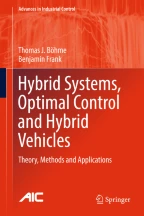Indirect Methods for Optimal Control

In this chapter, indirect methods to solve optimal control problems are discussed. Indirect methods rely on first-order necessary conditions, summarized in Pontryagin’s minimum principle, and attempt to locate control and state trajectories, which satisfy these conditions. An extension of the indirect shooting method for switched systems that yield a solution for systems of low complexity is presented in this chapter.
This is a preview of subscription content, log in via an institution to check access.
Access this chapter
Subscribe and save
Springer+ Basic
€32.70 /Month
- Get 10 units per month
- Download Article/Chapter or eBook
- 1 Unit = 1 Article or 1 Chapter
- Cancel anytime
Buy Now
Price includes VAT (France)
eBook EUR 106.99 Price includes VAT (France)
Softcover Book EUR 137.14 Price includes VAT (France)
Hardcover Book EUR 189.89 Price includes VAT (France)
Tax calculation will be finalised at checkout
Purchases are for personal use only
References
- Alamir M, Attia S (2004) On solving optimal control problems for switched hybrid nonlinear systems by strong variations algorithms. In: 6th IFAC symposium on nonlinear control systems (NOLCOS), Stuttgart, Germany, pp 558–563 Google Scholar
- Ascher UM, Mattheij RM, Russell RD (1994) Numerical solution of boundary value problems for ordinary differential equations, vol 13. SIAM Google Scholar
- Betts JT (1998) Survey of numerical methods for trajectory optimization. J Guidance Control Dyn 21(2):193–207 ArticleMATHGoogle Scholar
- Betts JT (2010) Practical methods for optimal control and estimation using nonlinear programming, 2nd edn. Society for Industrial and Applied Mathematics. doi:10.1137/1.9780898718577
- Bock H, Plitt K (1984) A multiple shooting algorithm for direct solution of optimal control problems. In: Proceedings of the 9th world congress of the international federation of automatic control, vol 9 Google Scholar
- Bryson A, Ho YC (1975) Applied Optimal Control—Optimization, Estimation and Control. Taylor and Francis Inc., New York Google Scholar
- Bulirsch R (1971) Die Mehrzielmethode zur numerischen Lösung von nichtlinearen Randwertproblemen und Aufgaben der optimalen Steuerung. Report der Carl-Cranz-Gesellschaft Google Scholar
- Dowell M, Jarrat P (1972) The Pegasus method for computing the root of an equation. BIT Numer Math 12:503–508 ArticleMathSciNetMATHGoogle Scholar
- Geering HP (2007) Optimal control with engineering applications. Springer, New York MATHGoogle Scholar
- Hager WW (2000) Runge-Kutta methods in optimal control and the transformed adjoint system. Numer Math 87(2):247–282 ArticleMathSciNetMATHGoogle Scholar
- Keller HB (1968) Numerical methods for two-point boundary-value problems. Blaisdell, London MATHGoogle Scholar
- Kirk D (1970) Optimal control theory: an introduction. Englewood Cliffs, Prentice-Hall Google Scholar
- Lukes DL (1969) Optimal regulation of nonlinear dynamical systems. SIAM J Control 7(1):75–100 ArticleMathSciNetMATHGoogle Scholar
- Oberle H, Grimm W (1989) BNDSCO—a program for the numerical solution of optimal control problems. In: Report no. 515 der DFVLR, Reihe B, Bericht 36 Google Scholar
- Osborne MR (1969) On shooting methods for boundary value problems. J Math Anal Appl 27(2):417–433 ArticleMathSciNetMATHGoogle Scholar
- Rao AV (2009) A survey of numerical methods for optimal control. Adv Astronaut Sci 135(1):497–528 Google Scholar
- Riedinger P, Kratz F (2003) An optimal control approach for hybrid systems. Eur J Control 9:449–458 ArticleMATHGoogle Scholar
- Riedinger P, Daafouz J, Iung C (2005) About solving hybrid optimal control problems. IMACS05 Google Scholar
- Shaikh MS (2004) Optimal control of hybrid systems: theory and algorithms. PhD thesis, Department of electrical and computer engineering, McGill University, Montreal Google Scholar
- Stengel RF (1994) Optimal control and estimation. Dover Publications Google Scholar
- von Stryk O, Bulirsch R (1992) Direct and indirect methods for trajectory optimization. Ann Oper Res 37:357–373 ArticleMathSciNetMATHGoogle Scholar
- Teo K, Jennings L (1989) Nonlinear optimal control problems with continuous state inequality constraints. J Optim Theory Appl 63(1):1–22 ArticleMathSciNetMATHGoogle Scholar
Author information
Authors and Affiliations
- IAV GmbH Ingenieurgesellschaft Auto und Verkehr, Gifhorn, Germany Thomas J. Böhme & Benjamin Frank
- Thomas J. Böhme

